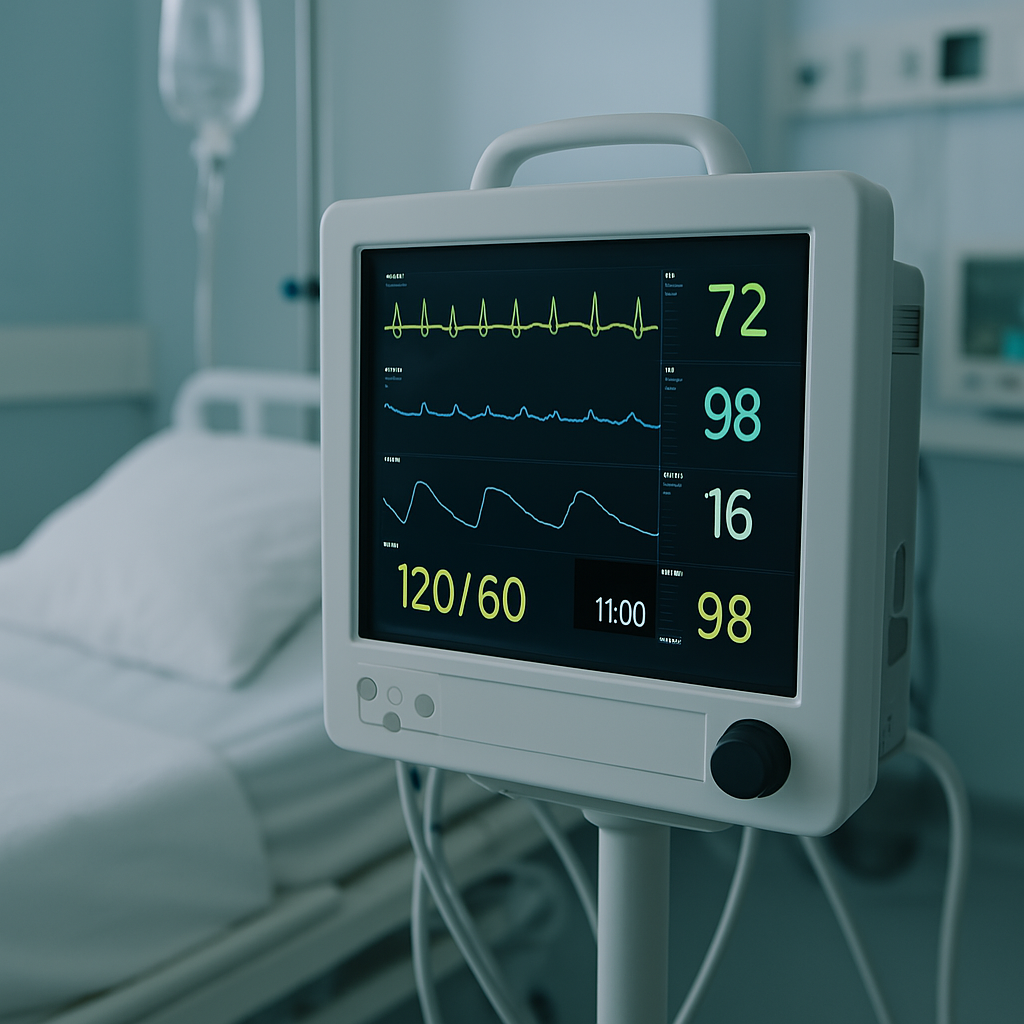How Patient Monitors Revolutionize Modern Healthcare: A Deep Dive

1. Introduction
Patient monitors are indispensable tools in modern medicine, used across hospitals, clinics, and emergency rooms to continuously track vital signs. These devices offer real-time insights into a patient’s physiological state, aiding healthcare providers in making timely, informed decisions. From basic heart rate tracking to advanced hemodynamic monitoring, patient monitors form the backbone of critical care.
2. What Are Patient Monitors?
Patient monitors are electronic medical devices designed to collect, display, and sometimes record a patient’s vital signs. They ensure rapid detection of changes in a patient’s condition, especially during surgery, recovery, or intensive care.
Core parameters include:
• Heart rate (HR)
• Blood pressure (BP)
• Oxygen saturation (SpO₂)
• Respiratory rate (RR)
• Body temperature
• Electrocardiogram (ECG)
3. Types of Patient Monitors
There are various types of patient monitors tailored to specific clinical needs:
a. Bedside Monitors
Fixed units used in ICUs, ERs, and ORs. Provide full vital sign monitoring.
b. Portable Monitors
Battery-operated, lightweight devices ideal for ambulance, transport, and ward use.
c. Wearable Monitors
New generation smart monitors for continuous data capture in home settings or post-op recovery.
d. Fetal and Neonatal Monitors
Used during labor and for premature infants to monitor fetal heart rate and oxygenation.
e. Multi-Parameter Monitors
Advanced monitors capable of displaying multiple vital signs simultaneously—essential in surgeries and critical care.
4. Key Features and Capabilities
Modern patient monitors go far beyond basic vital sign tracking. Key features include:
•Touchscreen interfaces for fast navigation
•Integrated alarms for out-of-range vitals
• Data storage and trend analysis
• Network connectivity to EHR systems
•Battery backup for mobile use or power failure
•Customizable displays based on clinical workflow
5. Common Applications
a. Operating Rooms (ORs):
Anesthesia teams monitor ECG, oxygenation, blood pressure, and more to ensure patient stability during surgery.
b. Intensive Care Units (ICUs):
Continuous monitoring of critically ill patients with real-time alerts.
c. Emergency Departments:
Quick triage and early detection of life-threatening conditions.
d. Wards and Recovery Rooms:
Intermittent or continuous monitoring for post-surgical patients.
e. Ambulatory and Home Settings:
Portable monitors allow early discharge and remote patient monitoring (RPM).
6. Vital Parameters Explained
Let’s explore the main parameters in more detail:
•Heart Rate (HR): Reflects the electrical activity of the heart (via ECG).
•SpO₂: Measures oxygen saturation using pulse oximetry. Normal > 95%.
•Non-Invasive Blood Pressure (NIBP): Measured via a cuff; crucial in hypertensive or shock patients.
•Respiratory Rate (RR): Indicates breathing cycles per minute; important in respiratory failure.
•Temperature: Indicates fever, infection, or post-op recovery issues.
•Capnography (EtCO₂): Tracks exhaled CO₂; critical during anesthesia.
7. Patient Monitor Brands and Models
Several global manufacturers lead the market:
• Philips IntelliVue Series
• GE Healthcare CARESCAPE
• Mindray BeneVision Series
• Dräger Infinity Monitors
• Nihon Kohden Life Scope
Each brand offers a range of devices from basic to high-end ICU models, often customizable.
8. Innovations in Patient Monitoring
Healthcare technology has rapidly evolved. Today’s patient monitors incorporate:
•AI Algorithms: For predictive analysis and early warning scores (EWS).
•Cloud Connectivity: Secure data sharing between departments or for telemedicine.
•Wireless ECG and SpO₂ Sensors: Reduce patient discomfort and increase mobility.
•Remote Monitoring Dashboards: Allow doctors to access patient data from tablets or computers.
•Touchless Monitoring: Camera-based systems for respiratory rate and movement tracking.
9. Challenges and Considerations
Despite their benefits, there are considerations when using patient monitors:
•Alarm Fatigue: Too many non-critical alerts can desensitize staff.
•Training Needs: Complex systems require proper user training.
•Calibration and Maintenance: Regular checks are essential for accuracy.
•Cost vs. Benefit: Budget constraints may limit access in smaller clinics.
Solutions include using smart alarm systems and vendor-supported training programs.
10. Regulatory and Safety Aspects
Patient monitors are regulated by authorities like the FDA (USA) or CE (Europe). Compliance ensures:
•Electrical and mechanical safety
•EMC (electromagnetic compatibility)
•Sterility of reusable parts
•Proper documentation and software validation
Clinics should only procure devices that meet these safety standards.
11. The Future of Patient Monitoring
The future lies in predictive and preventive care:
•AI-driven alerts to anticipate sepsis, arrhythmias, or cardiac arrest
• Integration with wearable tech like smartwatches
•Advanced home monitoring for chronic disease management
•Augmented reality (AR) overlays for faster interpretation
•Non-invasive monitoring replacing many traditional methods
These trends will reduce hospital stays and enable personalized care plans.
12. Conclusion
Patient monitors are revolutionizing healthcare by enabling constant, accurate, and actionable health insights. Their versatility across surgical suites, ICUs, emergency rooms, and even homes makes them an irreplaceable tool. As technology advances, these systems will continue to evolve—enhancing safety, improving clinical workflows, and ultimately saving lives.

